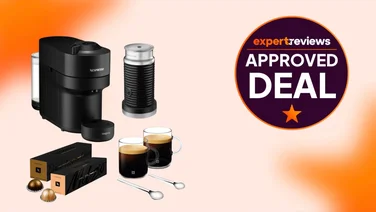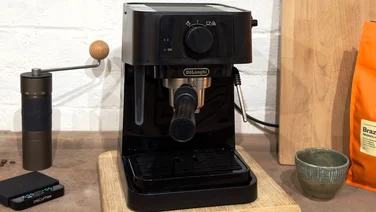To help us provide you with free impartial advice, we may earn a commission if you buy through links on our site. Learn more

- Affordable
- Easy to use
- Makes decent espresso
- Steaming power is lacking
- Steam controls could be better
- No unpressurised baskets included
Breville’s Barista Mini bears more than a passing resemblance to Sage’s family of coffee machines, which perhaps isn’t surprising given that both brands are owned by the same company in some parts of the world. However, the one relatively big difference is its price. Even at its RRP, the Barista Mini is just a mite more affordable than any of its doppelgangers in Sage’s line-up – and it manages to serve a respectable espresso, too.
Breville Barista Mini VCF125 review: What do you get for the money?
The Barista Mini is a compact manual espresso machine – a miniature version of the full-sized espresso machines you’ve seen in coffee shops. Simply press (or tamp, in coffee parlance) some ground coffee into the Barista Mini’s portafilter, twist it into place and it’ll serve up single or double shots of espresso. A steam wand allows you to manually steam a jug of milk, too, so you can put together milk-based coffees such as cappuccinos and flat whites with ease.
The design is smart. It’s a little wider than Sage’s Bambino or Duo Temp Pro, but that’s no big deal. There are a few panels of stainless steel across the front, and these mould seamlessly into grey plastic around the sides. It’s a good looking little machine.
The design is generally slick and sensible, too. The Barista Mini uses a 58mm diameter portafilter – this is the standard width for professional machines, so unusual to see at this price.
A two-litre water tank slots onto the rear, and there’s a ridged area on the top of the machine where you can warm cups before serving. Just like Sage’s machines, the drip tray slides out to reveal a little storage area where you can keep a couple of spare filter baskets – and maybe a small cleaning brush, if you have one to hand.
Speaking of accessories, you even get some bundled for free: there’s a small, stainless steel milk jug; a plastic coffee tamper; and a pair of filter baskets for producing single and double shots of espresso. All you need to do is add some ground coffee – and milk, if that’s your thing.
READ NEXT: These are the very best coffee machines that we’ve tested
Breville Barista Mini VCF125 review: What’s the coffee machine like to use?
As all the main controls are located on a single dial, this is an easy machine to use. The thermocoil design means that it heats up pretty quickly, too – far more so than machines with traditional water boilers. By the time you’ve tapped the power button, filled the portafilter basket with coffee, tamped it down and twisted it into place, the Barista Mini is just about ready to brew.
Turn the dial to the single cup icon and it’ll pour through enough water for a single shot; turn it all the way to the left and you’ll get a double shot. This will get you in the right kind of ballpark for pulling single or double shots of espresso, but you can be a little more exacting if you choose to be: turning the dial back to the centre manually stops the brew, or alternatively you can customise how much water is used for the single and double shots.

Unlike some machines, such as Sage’s Bambino Plus, the milk frothing is a manual affair. It does take a little practice to produce a silky, creamy microfoam, but even beginners will be able to get along just fine – the steam wand is much better than the ones you’ll find on budget rivals such as De’Longhi’s Dedica Style.
Admittedly, the steam wand hasn’t got a huge amount of steaming power behind it, so it takes longer to steam milk than the Sage Bambino (~£329) or Gaggia Classic (~£400), but the single nozzle does produce nice results if you’re willing to be patient. You can also use it to produce hot water if you want to make an americano, which is a nice touch – not all manual espresso machines provide this option.
It’s not all perfect, though: the steaming controls are a tad fiddly, for one thing. It’s necessary to turn the dial to the steaming setting, at which point the LED light starts to flash to indicate that it’s heating up. Once it’s heated up, the LED stops flashing and the wand just starts spraying out hot steam – and often a bit of water – which may catch people unawares. To be fair, you only have to wait around 45 seconds for it to reach temperature, but in our experience that is plenty long enough to get distracted and then find steam and water spraying everywhere.
Equally, the drip tray isn’t always that good at catching drips and splashes. It looks nice, but it doesn’t clip as firmly into place as we’d like and it could be a little deeper, too.
And while we’re on the subject of mess, the pressurised baskets are awful for it – they produce a horribly damp, squidgy puck of coffee that’s hard to get out of the portafilter and that makes a horrible coffee spattered mess when you try and knock them into the bin. That in itself is reason enough to shell out for some pressurised baskets, and we’ll discuss the benefits of those in detail in the next section.
Breville Barista Mini VCF125 review: Does it make good coffee?
The million dollar question is whether the Barista Mini can produce a good cup of coffee, and as ever that depends entirely on your definition of good. Yes, it can produce a perfectly drinkable cup of espresso, cappuccino or any combination of espresso, milk and/or water than you can dream up – it’s genuinely not bad at all for the money – but it’s not going to get coffee snobs into an enthusiastic froth.
Part of the problem is that Breville only supplies pressurised (or double-wall) baskets in the box. This type of basket is great for beginners and unfussy coffee drinkers, as they don’t require the coffee to be ground perfectly – you can use pretty much any ground coffee you can get your hands on. As the basket has a single hole in the outer shell, lots of pressure builds up inside and this helps to extract flavour from coarsely ground coffee, such as you’ll find on supermarket shelves.

If you want to take the time to buy nice coffee beans and grind them just so, you can buy unpressurised or single wall baskets from Breville. These will produce far better results if you have a good quality grinder: as the baskets have lots of evenly sized and spaced holes on the underside, they rely on the coffee being ground fine enough and consistently enough to provide the right amount of resistance to ensure that all the good flavours are extracted. Needless to say, that process requires a little time and knowledge in order to dial in the best possible results.
That said, I’m not convinced Breville has a giant killer on its hands here. For instance, I noticed that the pump doesn’t push water through the machine’s shower screen as evenly as it should, and further inspection revealed that the used coffee pucks did indeed tend to be a bit wetter on one side than the other. When it comes to getting the absolute most from your coffee, this isn’t something you want to see on a machine.
For those of you already thinking about upgrades: don’t rush into buying third-party accessories. The Breville might use a 58mm portafilter, but its locking mechanism is a three-ear design, so you’d need to make sure to buy the right type. Equally, not all 58mm baskets fit the Breville: the ones from our Gaggia Classic were too tall, as were our VST baskets, so you’ll either need to buy Breville’s own brand ones or take a punt on ridgeless alternatives from third-party retailers.
READ NEXT: Check out some of our favourite coffee grinders
Breville Barista Mini VCF125 review: Should you buy it?
It all comes down to price. If the Breville is retailing for its £299 RRP, and you want the best, most consistent espresso experience possible, then this probably isn’t the machine for you. In most cases, you should save up for a Gaggia Classic (~£400) instead: that’s a far better all-round machine that will last for years and also provides an upgrade path to all sorts of third-party upgrades such as PID temperature controls and brewing pressure adjustments. The Sage Bambino (£329) is a wonderfully hassle-free alternative, too – its superior build, more compact design and more consistent brewing marks it out as the better choice.
If the Breville’s street price dips back down below the £200 mark, however, it’s impossible to quibble with the value for money on offer here. This is a compact, attractively styled machine that produces decent coffee straight out of the box; if you can find it for a good price, it’ll trounce any other sub-£200 machine out there. Feed it supermarket coffee and it will serve up coffees that will quickly wean you off the big-name high street coffee chains – feed it better coffee, and it’ll give you a tantalising taste of what you’re missing. For the right price, you can’t say fairer than that.






